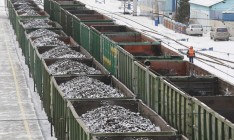Business
CrisisAlthough Russia resumed supplies of coal to Ukrainian TPPs, the plants are still experiencing a shortage

Last week the problems of maintaining Ukrainian thermal power plants with coal escalated to the bitter end. Shipments of coal ordered in Russia and fully paid for were held up at the Ukrainian border: Russian authorities did not give any explanation as to why the coal trains could not enter Ukraine. Meanwhile, according to Ukrenergo, as of December 2 the coal reserves at the Zmiyiv, Vuhlehirsk, Luhansk, Prydniprovska and Kryviy Rih TPPs were sufficient only for four days of operation. In addition to that, 21 units at TPPs and 1 unit at an NPP, which is a total capacity of almost 6,000 MW, were shut down for emergency repairs.
Production of electricity could not keep the pace of its consumption: some power companies exceeded their allocated limits in terms of electricity by 50% and capacity by 70%. Against the background of a cold snap across the country electricity consumption amounted to 25,200 MW (which is 11% more than on the same date last year), but the power shortage was 3,000–3,500 MW. «The use of emergency outage schedules on December 1–2 allowed for partially stabilizing the situation and preventing technological breakdowns in the power system,» said representatives of Ukrenergo.
But on December 3 the situation turned for the worse — another two units were shut down for repair works, and Ukrenergo was forced to impose restrictions to 3,100 MW. By the end of the week the situation deteriorated: as of the last Friday 28 units at TPPs and 1 unit at an NPP were under repair. In this regard, a schedule of restrictions on power consumption at the rate of 2,116 MW was introduced for peak periods of electricity consumption — from 8:00 am to 11:00 am and from 4:00 pm to 10:00 pm. However, at 10:50 am it became clear that power companies did not comply with the requirement to limit the consumption of electricity, so Ukrenergo raised the limit to 2,231 MW and in half an hour gave the order to shut off consumers from an additional 3,364 MW. Thus, the power shortage grew to 5,595 MW. For comparison, approximately the same capacity is produced by all six operating units of the largest Ukrainian NPPs in Zaporizhzhya.
Scraping the corners
Last Friday newly appointed Minister of the Energy and Coal Industry Volodymyr Demchyshyn said that power plants had approximately 1.4 million t of coal, but at the same time the amount of anthracite, which is in short supply and used at half of the 14 Ukrainian TPPs, is close to 250,000 t. The minister explained that due to the minimum reserves of coal power plants could not provide the necessary power and the worst situation with fuel was observed at the Prydniprovska, Kryviy Rih and Zmiyiv TPPs.
An expert, who requested anonymity, says that by Friday the situation with coal was a total catastrophe: «Stations running on anthracite coal have no reserves — some of them have anywhere from 3,000-10,000 tons,» said the source. Practically, this means that by Monday a number of stations operating on anthracite will have no choice but to shut down.
«The fact that consumers are now complaining about the blackouts is only one half of the problem,» the expert said on Friday. Based on rough estimates, thermal power plants produce approximately 30% of all electricity in the country. Half of all TPPs operate on anthracite coal and their shutdown may result in disconnection of approximately 15% of the country’s consumers. «The situation is very complicated and tough,» said the source.
Be that as it may, by Friday evening there were some rays of hope in a hopeless situation: the energy holding company DTEK announced that it agreed on the supply of coal to the Luhansk TPP from its mines in Rostov. DTEK Energo Business Director Vitaliy Butenko said live on the air of Hromadske TV that the first cars with the coal are already on the way, but delivery will take 3–4 days.
On Saturday, the Ministry of Energy reported that the 50,000 t lot of coal from Russia, which had previously been delayed at the border with Ukraine, continued on to the power station. However, this lot is only a small «gulp of air» for the TPPs, which are still operating on short rations. For example, according to Ukrenergo, just over one day (December 1) the TPPs burned almost 31,000 t of coal. For comparison, one 300 MW/day unit only needs 3,000 t of coal or more than 40 cars.
Thus, in the near future Ukrainian TPPs will be provided with coal based on the just-in-time system. The stability of the operation of the power system and disconnection of consumers will depend entirely on the rhythm and sufficiency of coal supplies by rail.
«Golden» reserves
The issue of starting up oil and gas units was raised amidst the shortage of coal. Those gas-operated units have been idle for the past 10 years due to the high cost of fuel. The last time they were started up was in 2007 due to irregular supplies of coal to the power stations. However, in November due to the shortage of coal one gas and oil unit was put into operation at the Trypillya TPP.
Capital’s source says that on Friday the Ministry of Energy and Coal Industry considered the possibility of allowing power stations to use gas instead of coal at coal-fired units. The source explained that the ministry was referring to small units up to 300 MW of capacity at the Trypillya and Zmiyiv TPPs. «It was not about operation, but about preparation of documents that would allow such operation,» said the source, explaining that such a move would drain gas reserves. «Three stations — Luhansk, Zmiyiv and Trypillya TPPs — wanted to use gas. The question was where could they get it? Only from the underground gas storage facilities! But in such a case we will be forced to deal with the issue of gas supply to the population in February!» said the source.
In this case, electricity produced with the use of gas instead of coal is much more expensive — the cost of 1 kW/h increases from 0.86 kopecks to UAH 2.
The use of fuel oil does not help the situation either. «When fuel oil is used instead of gas, electricity becomes even more expensive,» said another source familiar with the situation in the industry. Moreover, fuel oil reserves available in warehouses at the TPPs are also quite low: fuel oil consumption for production of 1 kW/h of electricity is 340–350 g. According to Ukrenergo, TPPs accumulated 113,000 t of fuel oil in their warehouses. According to our calculations, such an amount of fuel would be sufficient to produce approximately 330,000 MW/h of electricity. In other words, oil and gas units with a capacity of 2,000 MW that operate five hours a day will only be able to cover the power shortage for a month.






 of the agreement of syndication with Financial Times Limited are strictly prohibited. Use of materials which refers to France-Presse, Reuters, Interfax-Ukraine, Ukrainian News, UNIAN agencies is strictly prohibited. Materials marked
of the agreement of syndication with Financial Times Limited are strictly prohibited. Use of materials which refers to France-Presse, Reuters, Interfax-Ukraine, Ukrainian News, UNIAN agencies is strictly prohibited. Materials marked  are published as advertisements.
are published as advertisements.